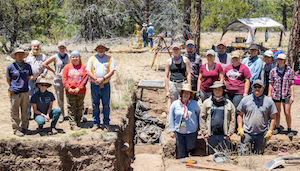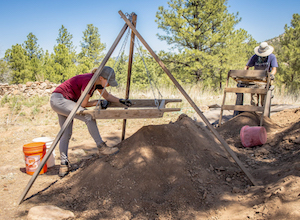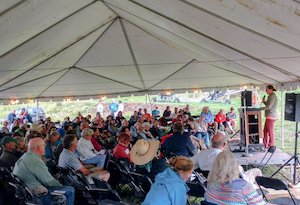 Thirteen New Mexico State University anthropology students attended the 2019 NMSU Archaeological Field School in the Gila National Forest. (NMSU Photo by Tom Conelly)It’s nothing like a day in the life of Indiana Jones, but New Mexico State University students can experience a day in the life of a real archaeologist at NMSU’s annual Archaeological Field School. This year’s six-week summer dig revealed more secrets about a curious structure at the South Diamond Creek Pueblo in the Gila National Forest –– a large ceremonial gathering place called a “Great Kiva.”
Thirteen New Mexico State University anthropology students attended the 2019 NMSU Archaeological Field School in the Gila National Forest. (NMSU Photo by Tom Conelly)It’s nothing like a day in the life of Indiana Jones, but New Mexico State University students can experience a day in the life of a real archaeologist at NMSU’s annual Archaeological Field School. This year’s six-week summer dig revealed more secrets about a curious structure at the South Diamond Creek Pueblo in the Gila National Forest –– a large ceremonial gathering place called a “Great Kiva.”
Lindsey Cron was among 13 NMSU anthropology students at this year’s Department of Anthropology field school at South Diamond Creek Pueblo. A graduate student, Cron served as a one of the crew chiefs at the excavation supervised by Fumi Arakawa, director of the University Museum at NMSU and an associate professor of anthropology in the College of Arts and Sciences.
NMSU has been excavating at this site in the Gila Wilderness since 2016. The project is an ongoing partnership with the U.S. Forest Service.  Desiree Apodaca, a New Mexico State University Anthropology student, works diligently during one of the many days of the NMSU Archaeology Field School. (NMSU Photo by Tom Conelly)Cron described the experience of being up at 6 a.m. and spending all day focused on the work of unveiling the past as inspiring, learning how to excavate pottery sherds, lithic tools and making discoveries. “One of the biggest discoveries from the field school was the fact we proved that the structure they started to excavate in 2017 was in fact a Kiva.”
Desiree Apodaca, a New Mexico State University Anthropology student, works diligently during one of the many days of the NMSU Archaeology Field School. (NMSU Photo by Tom Conelly)Cron described the experience of being up at 6 a.m. and spending all day focused on the work of unveiling the past as inspiring, learning how to excavate pottery sherds, lithic tools and making discoveries. “One of the biggest discoveries from the field school was the fact we proved that the structure they started to excavate in 2017 was in fact a Kiva.”
One of her team’s most important finds was the connection between the Mimbres Valley and the kiva. “Even though it (the Kiva) was 40 miles away, it was constructed with the same layout and construction method and features. So, the people who built the kiva probably had strong ties to the Mimbres Valley.”
Graduate assistant Jorden Scott described a typical day as involving anything from digging, mapping and photographing to soil sampling and sifting dirt for artifacts.
“We had lots of neat discoveries ranging from specific artifacts to interesting architecture,” said Scott who was also a crew chief and helped Arakawa run the field school. “I mean many of the students were really excited when we found artifacts on the floor, because these items have basically been there for about 1,400 years, but what I found the most incredible was the architecture. The kiva was 10 meters north to south and 9.26 meters from east to west, so we are looking at a huge structure that at the time of its construction would have been hand-dug with absolutely no metal tools.
“It’s amazing looking at the symmetry of this kiva and how much detail was put into the walls and the floors. It's hard to paint a picture with words, but when you look at what we exposed, you can’t help but see how incredibly intelligent and talented these people were. They knew how to build incredible structures with the materials they had around them and you can see this when you dig down through the layers of dirt that have been deposited over the past 1,000 years. I think being able to see this and understand what was going on such a long time ago is an incredible discovery on its own and everything else is just a bonus.” Ashley Stabenow, a New Mexico State University graduate student in Anthropology, presents her paper at the 2019 Pecos Conference in Cloudcroft, New Mexico. The conference had over 300 attendees. (NMSU Photo by Kelly Jenks.)While the field school participants are trained to find and preserve cultural artifacts, there are also practical reasons for archaeologists to take steps to save certain structures from natural destruction.
Ashley Stabenow, a New Mexico State University graduate student in Anthropology, presents her paper at the 2019 Pecos Conference in Cloudcroft, New Mexico. The conference had over 300 attendees. (NMSU Photo by Kelly Jenks.)While the field school participants are trained to find and preserve cultural artifacts, there are also practical reasons for archaeologists to take steps to save certain structures from natural destruction.
“The goal of the field school was to excavate some portions of what we call ‘Great Kiva,’ – a large, subterranean structure that ancient people built,” Arakawa said. We pretty much focused just on the ‘Great Kiva.’ We started the excavation on the site for mitigation purposes. Some of that pueblo structure has been eroded by water, so the Gila National Forest archaeologists asked us to do a salvage recovery, because if we left it like that, looters and pot hunters would go in there. We tried to excavate that structure to find out how those people lived, and why they had such a large communal structure and what kind of ceremonies and activities they performed there.”
NMSU anthropology students spent five nights a week camping at the Beaverhead Center near the Diamond Creek Pueblo and each day participated in all phases of archaeological fieldwork, including site survey, excavation mapping, and in-field analysis.
The dig offered students an opportunity to roll up their sleeves and get a first-hand look at what it takes to be an archaeologist/anthropologist. They learned time and monetary budgeting concepts while also conducting research. But attending the Pecos Conference offered them the chance to meet and exchange ideas with other anthropologists.
NMSU anthropology students were invited to present their findings at the Pecos Conference in Cloudcroft, N.M., which Arakawa and Scott coordinated. Each August, the conference is held in a different area, drawing archaeologists from the southwestern U.S. and northwestern Mexico to spend a few days sharing insights and research. Many of the archaeologists camped out in tents over Aug. 8-11 spending each day under one large tent listening to different speakers.
Field school students were asked to share their insights about what they discovered and in particular, their findings about the “Great Kiva.”
Scott along with Dustin Wagner, also a graduate student and crew chief on the field school, presented the team’s findings at the Pecos Conference. That too was a learning experience.
“There are a lot of well-known archaeologists who come to this conference and it can be scary to face people who wrote the books you study in school,” said Scott. However, it is also pretty cool to meet people and be seen as an equal or fellow scholar among so many great archaeologists.”